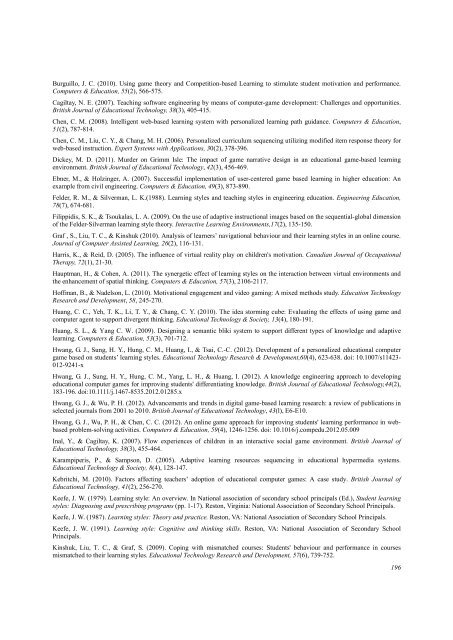Download Complete Issue in PDF - Educational Technology & Society
Download Complete Issue in PDF - Educational Technology & Society
Download Complete Issue in PDF - Educational Technology & Society
Create successful ePaper yourself
Turn your PDF publications into a flip-book with our unique Google optimized e-Paper software.
Burguillo, J. C. (2010). Us<strong>in</strong>g game theory and Competition-based Learn<strong>in</strong>g to stimulate student motivation and performance.<br />
Computers & Education, 55(2), 566-575.<br />
Cagiltay, N. E. (2007). Teach<strong>in</strong>g software eng<strong>in</strong>eer<strong>in</strong>g by means of computer-game development: Challenges and opportunities.<br />
British Journal of <strong>Educational</strong> <strong>Technology</strong>, 38(3), 405-415.<br />
Chen, C. M. (2008). Intelligent web-based learn<strong>in</strong>g system with personalized learn<strong>in</strong>g path guidance. Computers & Education,<br />
51(2), 787-814.<br />
Chen, C. M., Liu, C. Y., & Chang, M. H. (2006). Personalized curriculum sequenc<strong>in</strong>g utiliz<strong>in</strong>g modified item response theory for<br />
web-based <strong>in</strong>struction. Expert Systems with Applications, 30(2), 378-396.<br />
Dickey, M. D. (2011). Murder on Grimm Isle: The impact of game narrative design <strong>in</strong> an educational game-based learn<strong>in</strong>g<br />
environment. British Journal of <strong>Educational</strong> <strong>Technology</strong>, 42(3), 456-469.<br />
Ebner, M., & Holz<strong>in</strong>ger, A. (2007). Successful implementation of user-centered game based learn<strong>in</strong>g <strong>in</strong> higher education: An<br />
example from civil eng<strong>in</strong>eer<strong>in</strong>g. Computers & Education, 49(3), 873-890.<br />
Felder, R. M., & Silverman, L. K.(1988). Learn<strong>in</strong>g styles and teach<strong>in</strong>g styles <strong>in</strong> eng<strong>in</strong>eer<strong>in</strong>g education. Eng<strong>in</strong>eer<strong>in</strong>g Education,<br />
78(7), 674-681.<br />
Filippidis, S. K., & Tsoukalas, L. A. (2009). On the use of adaptive <strong>in</strong>structional images based on the sequential-global dimension<br />
of the Felder-Silverman learn<strong>in</strong>g style theory. Interactive Learn<strong>in</strong>g Environments,17(2), 135-150.<br />
Graf , S., Liu, T. C., & K<strong>in</strong>shuk (2010). Analysis of learners’ navigational behaviour and their learn<strong>in</strong>g styles <strong>in</strong> an onl<strong>in</strong>e course.<br />
Journal of Computer Assisted Learn<strong>in</strong>g, 26(2), 116-131.<br />
Harris, K., & Reid, D. (2005). The <strong>in</strong>fluence of virtual reality play on children's motivation. Canadian Journal of Occupational<br />
Therapy, 72(1), 21-30.<br />
Hauptman, H., & Cohen, A. (2011). The synergetic effect of learn<strong>in</strong>g styles on the <strong>in</strong>teraction between virtual environments and<br />
the enhancement of spatial th<strong>in</strong>k<strong>in</strong>g. Computers & Education, 57(3), 2106-2117.<br />
Hoffman, B., & Nadelson, L. (2010). Motivational engagement and video gam<strong>in</strong>g: A mixed methods study. Education <strong>Technology</strong><br />
Research and Development, 58, 245-270.<br />
Huang, C. C., Yeh, T. K., Li, T. Y., & Chang, C. Y. (2010). The idea storm<strong>in</strong>g cube: Evaluat<strong>in</strong>g the effects of us<strong>in</strong>g game and<br />
computer agent to support divergent th<strong>in</strong>k<strong>in</strong>g. <strong>Educational</strong> <strong>Technology</strong> & <strong>Society</strong>, 13(4), 180-191.<br />
Huang, S. L., & Yang C. W. (2009). Design<strong>in</strong>g a semantic bliki system to support different types of knowledge and adaptive<br />
learn<strong>in</strong>g. Computers & Education, 53(3), 701-712.<br />
Hwang, G. J., Sung, H. Y., Hung, C. M., Huang, I., & Tsai, C.-C. (2012). Development of a personalized educational computer<br />
game based on students’ learn<strong>in</strong>g styles. <strong>Educational</strong> <strong>Technology</strong> Research & Development,60(4), 623-638. doi: 10.1007/s11423-<br />
012-9241-x<br />
Hwang, G. J., Sung, H. Y., Hung, C. M., Yang, L. H., & Huang, I. (2012). A knowledge eng<strong>in</strong>eer<strong>in</strong>g approach to develop<strong>in</strong>g<br />
educational computer games for improv<strong>in</strong>g students' differentiat<strong>in</strong>g knowledge. British Journal of <strong>Educational</strong> <strong>Technology</strong>,44(2),<br />
183-196. doi:10.1111/j.1467-8535.2012.01285.x<br />
Hwang, G. J., & Wu, P. H. (2012). Advancements and trends <strong>in</strong> digital game-based learn<strong>in</strong>g research: a review of publications <strong>in</strong><br />
selected journals from 2001 to 2010. British Journal of <strong>Educational</strong> <strong>Technology</strong>, 43(l), E6-E10.<br />
Hwang, G. J., Wu, P. H., & Chen, C. C. (2012). An onl<strong>in</strong>e game approach for improv<strong>in</strong>g students' learn<strong>in</strong>g performance <strong>in</strong> webbased<br />
problem-solv<strong>in</strong>g activities. Computers & Education, 59(4), 1246-1256. doi: 10.1016/j.compedu.2012.05.009<br />
Inal, Y., & Cagiltay, K. (2007). Flow experiences of children <strong>in</strong> an <strong>in</strong>teractive social game environment. British Journal of<br />
<strong>Educational</strong> <strong>Technology</strong>, 38(3), 455-464.<br />
Karampiperis, P., & Sampson, D. (2005). Adaptive learn<strong>in</strong>g resources sequenc<strong>in</strong>g <strong>in</strong> educational hypermedia systems.<br />
<strong>Educational</strong> <strong>Technology</strong> & <strong>Society</strong>, 8(4), 128-147.<br />
Kebritchi, M. (2010). Factors affect<strong>in</strong>g teachers’ adoption of educational computer games: A case study. British Journal of<br />
<strong>Educational</strong> <strong>Technology</strong>, 41(2), 256-270.<br />
Keefe, J. W. (1979). Learn<strong>in</strong>g style: An overview. In National association of secondary school pr<strong>in</strong>cipals (Ed.), Student learn<strong>in</strong>g<br />
styles: Diagnos<strong>in</strong>g and prescrib<strong>in</strong>g programs (pp. 1-17). Reston, Virg<strong>in</strong>ia: National Association of Secondary School Pr<strong>in</strong>cipals.<br />
Keefe, J. W. (1987). Learn<strong>in</strong>g styles: Theory and practice. Reston, VA: National Association of Secondary School Pr<strong>in</strong>cipals.<br />
Keefe, J. W. (1991). Learn<strong>in</strong>g style: Cognitive and th<strong>in</strong>k<strong>in</strong>g skills. Reston, VA: National Association of Secondary School<br />
Pr<strong>in</strong>cipals.<br />
K<strong>in</strong>shuk, Liu, T. C., & Graf, S. (2009). Cop<strong>in</strong>g with mismatched courses: Students' behaviour and performance <strong>in</strong> courses<br />
mismatched to their learn<strong>in</strong>g styles. <strong>Educational</strong> <strong>Technology</strong> Research and Development, 57(6), 739-752.<br />
196

















